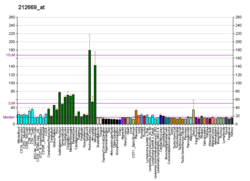CAMK2G
Calcium/calmodulin-dependent protein kinase type II gamma chain is an enzyme that in humans is encoded by the CAMK2G gene.[3]
Function
The product of this gene belongs to the Serine/Threonine protein kinase family, and to the Ca(2+)/calmodulin-dependent protein kinase subfamily. Calcium signaling is crucial for several aspects of plasticity at glutamatergic synapses. In mammalian cells the enzyme is composed of four different chains: alpha, beta, gamma, and delta. The product of this gene is a gamma chain. Six alternatively spliced variants that encode six different isoforms have been characterized to date. Additional alternative splice variants that encode different isoforms have been described, but their full-length nature has not been determined.[4]
Interactions
CAMK2G has been shown to interact with RRAD.[5]
See also
References
- ↑ "Human PubMed Reference:".
- ↑ "Mouse PubMed Reference:".
- ↑ Li X, Nghiem P, Schulman H, Francke U (Feb 1994). "Localization of the CAMKG gene encoding gamma isoforms of multifunctional calcium/calmodulin-dependent protein kinase (CaM kinase) to human chromosome 10 band q22 and mouse chromosome 14". Cytogenet Cell Genet. 66 (2): 113–6. PMID 8287681. doi:10.1159/000133679.
- ↑ "Entrez Gene: CAMK2G calcium/calmodulin-dependent protein kinase (CaM kinase) II gamma".
- ↑ Moyers JS, Bilan PJ, Zhu J, Kahn CR (May 1997). "Rad and Rad-related GTPases interact with calmodulin and calmodulin-dependent protein kinase II". J. Biol. Chem. 272 (18): 11832–9. PMID 9115241. doi:10.1074/jbc.272.18.11832.
Further reading
- Hook SS, Means AR (2001). "Ca(2+)/CaM-dependent kinases: from activation to function.". Annu. Rev. Pharmacol. Toxicol. 41: 471–505. PMID 11264466. doi:10.1146/annurev.pharmtox.41.1.471.
- Yamamoto H (2002). "[Molecular mechanisms of the intracellular localizations of Ca2+/calmodulin-dependent protein kinase II isoforms, and their physiological functions]". Tanpakushitsu Kakusan Koso. 47 (3): 241–7. PMID 11889801.
- Countaway JL, Nairn AC, Davis RJ (1992). "Mechanism of desensitization of the epidermal growth factor receptor protein-tyrosine kinase.". J. Biol. Chem. 267 (2): 1129–40. PMID 1309762.
- Ikebe M, Reardon S (1990). "Phosphorylation of smooth myosin light chain kinase by smooth muscle Ca2+/calmodulin-dependent multifunctional protein kinase.". J. Biol. Chem. 265 (16): 8975–8. PMID 2160950.
- Czernik AJ, Pang DT, Greengard P (1987). "Amino acid sequences surrounding the cAMP-dependent and calcium/calmodulin-dependent phosphorylation sites in rat and bovine synapsin I.". Proc. Natl. Acad. Sci. U.S.A. 84 (21): 7518–22. PMC 299327
 . PMID 3118371. doi:10.1073/pnas.84.21.7518.
. PMID 3118371. doi:10.1073/pnas.84.21.7518. - Vulliet PR, Woodgett JR, Cohen P (1984). "Phosphorylation of tyrosine hydroxylase by calmodulin-dependent multiprotein kinase.". J. Biol. Chem. 259 (22): 13680–3. PMID 6150037.
- Wen Z, Zhong Z, Darnell JE (1995). "Maximal activation of transcription by Stat1 and Stat3 requires both tyrosine and serine phosphorylation.". Cell. 82 (2): 241–50. PMID 7543024. doi:10.1016/0092-8674(95)90311-9.
- Kwiatkowski AP, McGill JM (1995). "Human biliary epithelial cell line Mz-ChA-1 expresses new isoforms of calmodulin-dependent protein kinase II.". Gastroenterology. 109 (4): 1316–23. PMID 7557101. doi:10.1016/0016-5085(95)90594-4.
- Shuai K, Stark GR, Kerr IM, Darnell JE (1993). "A single phosphotyrosine residue of Stat91 required for gene activation by interferon-gamma.". Science. 261 (5129): 1744–6. PMID 7690989. doi:10.1126/science.7690989.
- Zhu J, Reynet C, Caldwell JS, Kahn CR (1995). "Characterization of Rad, a new member of Ras/GTPase superfamily, and its regulation by a unique GTPase-activating protein (GAP)-like activity.". J. Biol. Chem. 270 (9): 4805–12. PMID 7876254. doi:10.1074/jbc.270.9.4805.
- Yakel JL, Vissavajjhala P, Derkach VA, Brickey DA, Soderling TR (1995). "Identification of a Ca2+/calmodulin-dependent protein kinase II regulatory phosphorylation site in non-N-methyl-D-aspartate glutamate receptors.". Proc. Natl. Acad. Sci. U.S.A. 92 (5): 1376–80. PMC 42522
 . PMID 7877986. doi:10.1073/pnas.92.5.1376.
. PMID 7877986. doi:10.1073/pnas.92.5.1376. - Maruyama K, Sugano S (1994). "Oligo-capping: a simple method to replace the cap structure of eukaryotic mRNAs with oligoribonucleotides.". Gene. 138 (1–2): 171–4. PMID 8125298. doi:10.1016/0378-1119(94)90802-8.
- Suko J, Maurer-Fogy I, Plank B, Bertel O, Wyskovsky W, Hohenegger M, Hellmann G (1993). "Phosphorylation of serine 2843 in ryanodine receptor-calcium release channel of skeletal muscle by cAMP-, cGMP- and CaM-dependent protein kinase". Biochim. Biophys. Acta. 1175 (2): 193–206. PMID 8380342. doi:10.1016/0167-4889(93)90023-I.
- de Groot RP, den Hertog J, Vandenheede JR, Goris J, Sassone-Corsi P (1993). "Multiple and cooperative phosphorylation events regulate the CREM activator function". EMBO J. 12 (10): 3903–11. PMC 413673
 . PMID 8404858.
. PMID 8404858. - Nghiem P, Saati SM, Martens CL, Gardner P, Schulman H (1993). "Cloning and analysis of two new isoforms of multifunctional Ca2+/calmodulin-dependent protein kinase. Expression in multiple human tissues". J. Biol. Chem. 268 (8): 5471–9. PMID 8449910.
- Shimomura A, Ogawa Y, Kitani T, Fujisawa H, Hagiwara M (1996). "Calmodulin-dependent protein kinase II potentiates transcriptional activation through activating transcription factor 1 but not cAMP response element-binding protein". J. Biol. Chem. 271 (30): 17957–60. PMID 8663317. doi:10.1074/jbc.271.30.17957.
- Wei J, Wayman G, Storm DR (1996). "Phosphorylation and inhibition of type III adenylyl cyclase by calmodulin-dependent protein kinase II in vivo". J. Biol. Chem. 271 (39): 24231–5. PMID 8798667. doi:10.1074/jbc.271.39.24231.
- Tombes RM, Krystal GW (1997). "Identification of novel human tumor cell-specific CaMK-II variants". Biochim. Biophys. Acta. 1355 (3): 281–92. PMID 9060999. doi:10.1016/S0167-4889(96)00141-3.
- Moyers JS, Bilan PJ, Zhu J, Kahn CR (1997). "Rad and Rad-related GTPases interact with calmodulin and calmodulin-dependent protein kinase II". J. Biol. Chem. 272 (18): 11832–9. PMID 9115241. doi:10.1074/jbc.272.18.11832.
External links
- Human CAMK2G genome location and CAMK2G gene details page in the UCSC Genome Browser.
This article incorporates text from the United States National Library of Medicine, which is in the public domain.



